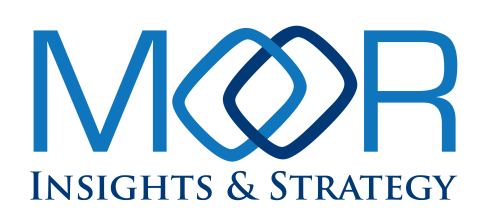
Welcome to this edition of our Weekly Analyst Insights roundup, which features key insights our analysts have developed based on the past week’s events.

Last week the CEOs of AMD (Lisu Su, right) and Intel (Pat Gelsinger, left), did something unexpected: they joined forces to launch the x86 Ecosystem Advisory Group. The new entity aims to boost interoperability, smooth out integration, and generally simplify life for developers, ISVs, OS makers, and OEMs in the x86 space. Our own CEO and chief analyst, Patrick Moorhead, has known Gelsinger and Su for years. He had the opportunity to conduct a 1-on-2 interview with the two of them a day ahead of the public announcement, which led to this full-length analysis on Forbes.
The busy autumn conference season continues for our team. Last week, Melody was at AdobeMAX in Miami, and Patrick, Matt, Paul, and Anshel were in Bellevue, Washington, for Lenovo’s Global Analyst Summit & Tech World. Will was at Blackberry’s Analyst Day, and Matt, Robert, and Jason participated in IBM’s Analyst Day—all in the Big Apple.
On Thursday, October 17, Melody joined the RingCentral team on the webinar “Revealing the AI Communications Strategies That Work” where she shared her vision for the future of AI in UC. If you missed it, you can watch it here on demand.
This week, the team continues its tech event travels. Patrick and Will are set to attend Qualcomm’s Snapdragon Summit in Maui, Melody returns to Florida for WebexOne in Ft Lauderdale, and Matt will attend the RISC-V Summit virtually.
Our MI&S team published 21 deliverables:
Over the last week, our analysts have been quoted in numerous top-tier international publications with our thoughts on AMD, Nvidia, Intel, Apple Vision Pro, Pure Storage, UL Solutions, the smartphone market, and of course, chips and AI.
MI&S Quick Insights
Last week I attended the IBM Analyst Summit in New York. As typical at these events, much of what was covered was under embargo. The good news is that the embargo will be lifted this week in concert with the IBM TechXChange event in Las Vegas. However, I was pleasantly surprised to hear what was going on in IBM Consulting. This was in terms of both the nature of their work and how they are delivering projects for clients. I will be doing more in-depth research on this topic in the coming weeks.
Over the past couple of weeks, I have gotten a great deal of feedback and dialogue regarding my recent Forbes column on Agents. The conversations have led to two very interesting pieces of feedback. First, there seems to be a bifurcation between the agent development method and the focus of tooling vendors. To wit, low- and no-code tool makers are pumping out hundreds of general-purpose agents to help knowledge workers empower themselves. This is exemplified by recent announcements from Oracle, Salesforce, ServiceNow, and others. Meanwhile, the vendors more aligned to pro-code tools are more focused on specific problems. A good example of this is AWS with application modernization. AWS is not alone, as other pro-code vendors are lining up around more specific use cases and will unveil their visions this year. This recent turn of events is leading to the second point of feedback, which is how customers should approach starting to use agents. This seems like a great piece of future research, so stay tuned.
On a more personal note, I am experimenting with how I do my research. I have always been a note-taker, carrying my pads, pens, and pencils wherever I go. The physical writing process helps my brain cement ideas in place, and my constant doodling helps me see patterns in my research. I have never been able to type my notes, and while Patrick Moorhead (among others) is a big fan of meeting transcription, I think I still need the physical act of writing things down.
However, after decades of using this method, I might be making a change—or at least an evolution. After trying to go digital for years, AI-empowered notebooks may be the catalyst to push me over the top. The challenge of using pen and paper is retention over longer periods. Locating things in old notebooks is a pain, and not available when I am on the road. The idea of adding LLMs to digital notebooks means I can combine my notes with other artifacts and start to really dig into areas of interest and be more efficient as I develop research. I must be clear: I am not using LLMs to do my writing in any way. But they are a good way to organize thoughts and possibly prompt me to look at some areas in a more nuanced way. So far, so good on making notes; there is a learning curve, but I am starting to get it. I am still testing out what will become my digital notebook, and I’ll keep you posted here. My setup is in the “New Gear” section below.
Last week I attended the IBM Analyst Summit in New York. As typical at these events, much of what was covered was under embargo. The good news is that the embargo will be lifted this week in concert with the IBM TechXChange event in Las Vegas. However, I was pleasantly surprised to hear what was going on in IBM Consulting. This was in terms of both the nature of their work and how they are delivering projects for clients. I will be doing more in-depth research on this topic in the coming weeks.
Over the past couple of weeks, I have gotten a great deal of feedback and dialogue regarding my recent Forbes column on Agents. The conversations have led to two very interesting pieces of feedback. First, there seems to be a bifurcation between the agent development method and the focus of tooling vendors. To wit, low- and no-code tool makers are pumping out hundreds of general-purpose agents to help knowledge workers empower themselves. This is exemplified by recent announcements from Oracle, Salesforce, ServiceNow, and others. Meanwhile, the vendors more aligned to pro-code tools are more focused on specific problems. A good example of this is AWS with application modernization. AWS is not alone, as other pro-code vendors are lining up around more specific use cases and will unveil their visions this year. This recent turn of events is leading to the second point of feedback, which is how customers should approach starting to use agents. This seems like a great piece of future research, so stay tuned.
On a more personal note, I am experimenting with how I do my research. I have always been a note-taker, carrying my pads, pens, and pencils wherever I go. The physical writing process helps my brain cement ideas in place, and my constant doodling helps me see patterns in my research. I have never been able to type my notes, and while Patrick Moorhead (among others) is a big fan of meeting transcription, I think I still need the physical act of writing things down.
However, after decades of using this method, I might be making a change—or at least an evolution. After trying to go digital for years, AI-empowered notebooks may be the catalyst to push me over the top. The challenge of using pen and paper is retention over longer periods. Locating things in old notebooks is a pain, and not available when I am on the road. The idea of adding LLMs to digital notebooks means I can combine my notes with other artifacts and start to really dig into areas of interest and be more efficient as I develop research. I must be clear: I am not using LLMs to do my writing in any way. But they are a good way to organize thoughts and possibly prompt me to look at some areas in a more nuanced way. So far, so good on making notes; there is a learning curve, but I am starting to get it. I am still testing out what will become my digital notebook, and I’ll keep you posted here. My setup is in the “New Gear” section below.
Dario Amodei, CEO of Anthropic, has written a very long (but interesting) paper on what he believes will be the ultimate gifts of AI. His idea is that after powerful AI is developed, we will, within a few years, make all the progress in biology and medicine that we would have made in the entire 21st century without AI. Amodei said, “I think that most people are underestimating just how radical the upside of AI could be, just as I think most people are underestimating how bad the risks could be.” Here’s a list of what he believes AI-enabled biology and medicine will give us in five to 10 years that would otherwise take 50 to 100 years without AI:
- Reliable prevention and treatment of nearly all infectious disease
- Elimination of most cancer
- Very effective prevention and effective cures for genetic disease
- Prevention of Alzheimer’s
- Improved treatment of most other ailments
- Biological freedom (To explain this, he wrote, “I suspect AI-accelerated biology will greatly expand what is possible: weight, physical appearance, reproduction, and other biological processes will be fully under people’s control.”)
- Doubling of the human lifespan
The list seems doable based on the work being done with AI, medicine, and healthcare. If you want to read the entire paper, you’ll find it here.
Robots seem to be a hot topic now, probably thanks to Elon Musk. Boston Dynamics and Toyota Research Institute announced a robotics research partnership to combine their expertise in AI and robotics. The partnership plans to accelerate the development of humanoids by integrating TRI’s large behavior models with Boston Dynamics’ Atlas robots. The robots will be the platform for implementing TRI’s advanced AI systems. TRI has expertise in computer vision; LLM training will also be important to develop a multitasking foundation model for robotic manipulation. Once we develop AGI and incorporate it into a humanoid, we might be approaching the danger zone. Then again, that might be a lot of fun.
At the GITEX Global conference in Dubai, Avaya showcased its latest AI-powered solutions aimed at enhancing customer experience and streamlining operations. These included “Amna,” an AI virtual assistant developed in partnership with Sestek and Cognigy for Dubai Police to handle public inquiries. Avaya also introduced a “Virtual Operations Manager” concept, demonstrating how AI can analyze contact center data and provide actionable insights to improve performance and customer journeys. Furthermore, Avaya highlighted a real-time translation solution created with Transcom and Sabio, leveraging Avaya Experience Platform’s open APIs to enable agents to communicate with customers in more than 100 languages. This solution aims to improve scalability and reduce business costs by up to 65% in specific markets and use cases.
I attended GITEX with Avaya last year, and I’ve seen firsthand how the company leverages this event to highlight its commitment to innovation in the CX space. While I couldn’t be there in person this year, I have observed how these announcements reinforce Avaya’s focus on delivering solutions that address real-world challenges. It’s particularly noteworthy to see the company’s emphasis on practical applications of AI, such as the virtual assistant for Dubai Police and the real-time translation solution, which have the potential to significantly impact customer service and operational efficiency.
Although I had to sit in my hotel room and watch the Lenovo Tech World 2024 livestream due to bronchitis, there was a lot of news to digest from this company, which I believe doesn’t get enough credit for its AI programs and the other strong work it has done in the market. One of those areas is an enabling technology: Neptune liquid cooling. Although this technology really has its roots in the IBM era, Lenovo has done a lot to advance it—and indeed has been on the forefront of the liquid cooling trend. In this vein, Lenovo made two major announcements at Tech World:
- The new Lenovo N1380 Neptune chassis is designed for 100% heat removal on a greater than 100kW rack consumption, without any specialized air conditioning.
- The ThinkSystem SC777 v4 Neptune server supports the NVIDIA Blackwell GPU and platform.
It used to be that a 15kW power budget for a whole server rack was high. Thanks to the accelerated adoption of higher-power-consuming CPUs and GPUs, it is not unusual anymore to see 15kW being consumed by a single server. Liquid cooling is quickly moving from niche usage in the datacenter to much broader adoption. In response, Lenovo has played to its strength in liquid cooling quite effectively.
Speaking of liquid cooling, infrastructure giant Schneider just secured a controlling interest in liquid air player Motivair for $850 million. Schneider does a lot in the datacenter market—electrical distribution, UPS kits, racks, enclosures, etc. This investment is a natural and smart expansion for the company. What makes it more interesting to me is the amount of money pouring into the liquid cooling market—and the innovation that is coming out of these startups.
One of the more interesting liquid cooling companies I’ve seen is JetCool out of Maynard, Massachusetts. This company, founded by a scientist from the MIT Lincoln Laboratory, has been securing more and more partnerships and recently secured tens of millions in investment from Bosch.
To think of liquid cooling as mere plumbing is silly. It has moved from low-tech to high-tech seemingly overnight as it has gone from pumping fluids to advanced physics. Look for a research note from me on this topic in the near future.
Are we living in the era of real-life science fiction? When Oracle CEO Larry Ellison talked about using nuclear power to light up his datacenters, people kind of laughed and thought of it as “Larry being Larry.” Fast-forward a month or two, and Microsoft is wanting to reactivate Three Mile Island to power its Azure datacenters, while Google and AWS have committed to acquiring and deploying small modular reactors (SMRs) that can deliver up to 300 megawatts of power per datacenter.
The power crunch is very real—and very limiting. If SMRs can be deployed and managed properly, they could deliver highly reliable and very clean energy for next-generation datacenters. Hopefully, U.S. regulators will come to their collective senses and catch up with the rest of the world in enabling nuclear power.
Adobe announced GenStudio for Performance Marketing at its AdobeMAX conference in Miami last week. This generative AI-powered application aims to help brands and agencies accelerate the creation and delivery of personalized marketing campaigns, allowing marketers to quickly generate variations of on-brand content for channels such as paid social, display ads, and e-mail. The platform integrates with Adobe Experience Cloud and with popular advertising platforms such as Google, Meta, and TikTok, offering performance insights and streamlined workflows.
This was just one of several announcements at AdobeMAX, including new Adobe Express integrations with popular enterprise apps such as Box and Miro. I’ll soon provide a more detailed analysis of these announcements and my experience at the conference.
Cloudera’s partnership with Snowflake provides enterprises with an open, unified hybrid data lakehouse powered by Apache Iceberg. The goal of this collaboration is to enable enterprises to consolidate their data, analytics, and AI workloads into a single platform, eliminating data silos. This combination could give enterprises a single source of truth for their data, enabling faster queries, real-time insights, and streamlined workflows while maintaining data integrity. “By extending our open data lakehouse capabilities through Apache Iceberg to Snowflake, we’re enabling our customers to not only optimize their data workflows but also unlock new opportunities for innovation, efficiency, and growth,” said Abhas Ricky, chief strategy officer of Cloudera.
Last week I attended IBM’s Analyst Summit in New York, which provided valuable insights into IBM’s vision for the future of data and AI, with an emphasis on accessing enterprise data. Beyond exploring IBM’s impressive new offices, I had the opportunity to hear from key leaders, starting with CEO Arvind Krishna, who outlined IBM’s strategy for AI adoption, sustainability, partnerships, and data management. SVP of software and CCO Rob Thomas detailed IBM’s software approach to leveraging data and AI, while SVP and director of IBM Research Dr. Dario Gil highlighted innovative AI research from IBM labs. I was especially interested to learn more about how IBM’s consulting services are helping clients navigate digital transformation and customer readiness, get the most out of structured and unstructured enterprise data using IBM’s data fabric solutions, and adopt sustainable data practices in anticipation of future regulations..
AMD’s recent announcements of its new DPU and Ultra Ethernet Consortium-ready NIC represent a one-two punch supporting front- and back-end networking that’s optimized for AI workloads. The AMD Pensando Salina DPU marries high-performance network interconnect capabilities and acceleration engines aimed at providing critical offload to improve AI and ML functions. AMD claims that Salina will provide a twofold improvement in overall performance over its prior DPU generations, and if it delivers on this promise, it could further the company’s design wins with public cloud service providers eager to capitalize on the AI gold rush.
The Pensando Pollara 400 NIC is purpose-built for AI workloads, with an architecture based on the latest version of RDMA that can directly connect to host memory without CPU intervention. AMD’s new NIC design could position it favorably relative to Broadcom 400G Thor, especially since the company is the first out of the gate with a design optimized for UEC performance. Both the AMD Pensando Salina DPU and AMD Pensando Pollara 400 NIC are currently sampling with cloud service and infrastructure providers; commercial shipments are expected in the first half of 2025.
SAP and UiPath have formed a partnership to integrate the UiPath enterprise automation platform with SAP Build Process Automation. Among other benefits, this move aims to enable customers to automate more of their business processes, plus it should make things easier for enterprises that are transitioning to SAP S/4HANA Cloud. UiPath touts the collaboration, offered as an SAP Solution Extension starting this month, as providing a holistic view of process automation across both SAP and non-SAP environments to enhance operations and efficiencies.
This is an option worth exploring for enterprises transitioning to SAP S/4HANA Cloud and automating processes across their IT landscape. Both partners have a focus on enabling enterprises to carry out successful business transformation projects while improving data management and reducing risks.
NXP introduced the S32J family of 80 Gbps Ethernet switches, which share a common switch core (NETC) with the NXP S32 automotive processing platform. Designed for high-speed in-vehicle networks, the switch integrates with NXP’s CoreRide platform to provide production-grade network solutions pre-integrated with software and tooling.
Sonatus, a leader in software-defined vehicle technologies, won Autotech Breakthrough’s “Connected Vehicle Innovation of the Year” award for the Sonatus Collector data collection system. Only a fraction of the massive amount of vehicle-generated data is relevant for optimizing customer experiences, improving quality, managing fleets, and ensuring safety. The Collector is a policy-based system that reduces data processing overhead and upload costs by gathering, storing, and uploading only targeted information. This solution is truly innovative, and other industrial applications should use similar design patterns.
Blecon, a new startup out of Cambridge, England, punched above its weight class last week at Embedded World NA with a simple middleware solution that connects Bluetooth Low Energy devices to cloud services—without pairing. The company just closed a $4.6 million seed round led by U.K.-based MMC Ventures. I like simple connectivity schemes, and this is a good one.
Agtonomy closed its $32.8 million Series A round, positioning the company to accelerate AI-driven agriculture automation and expand into autonomous industrial equipment. Agtonomy’s Sonatus-like business model combines advanced software with OEM partnerships to rapidly develop various autonomous, software-defined offroad products.
In recent conversations with various tech vendors, it’s become clear to me that while enterprises are eager to adopt AI, they face many of the same key challenges. IBM recently highlighted five truths about AI adoption, emphasizing the need for:
- Targeted AI solutions
- Hybrid cloud flexibility
- Robust governance
- A focus on value-driven use cases
- High-quality data
These points resonate with my own observations and are further validated by a recent Cisco study that revealed a disconnect between what tech companies think their customers need and the customers’ actual challenges and needs.
This misalignment is particularly evident in infrastructure scalability, data security, and access to skilled talent. While partners are understandably enthusiastic about the growth potential of the AI market, they need to better understand and address these customer pain points to capitalize on this opportunity. It’s not just about selling the “shiny new object” of AI, but about providing practical solutions that deliver real business value and foster trust in AI systems.
Lenovo held its Tech World 2024 event in conjunction with its global analyst conference. At the event, the company had a Who’s Who of tech executives on stage, including Intel’s Pat Gelsinger, AMD’s Lisa Su, and NVIDIA’s Jensen Huang. (Qualcomm’s Cristiano Amon and Microsoft’s Satya Nadella joined via video.) It was absolutely a tour de force for Lenovo to remind its partners of the company’s influence as the world’s undisputed #1 PC maker. While Lenovo didn’t announce any new consumer products, it did show off many concepts and prototypes. It also announced its foray into automotive electronics in partnership with NVIDIA and Qualcomm.
Amazon overhauled its entire Kindle lineup with new and improved models and the first-ever color Kindle, which it claims will operate in full color with zero impact on battery life. I am glad to see a color Kindle because it improves the reading experience for graphic novels. There are also a bunch of updated models of Kindle Paperwhite, Kindle Scribe and Kindle with new colors and faster page loading. These new Kindles have phased out the previous generation, including the last model with physical buttons.
Quantum Computing Inc. has won its fifth project from NASA. The company is developing quantum remote sensing for space-based lidar imaging. By using QCI’s technology, NASA will lower the cost of lidar missions. This is an important step for QCI that allows it to provide an innovative quantum solution using remote sensing for climate change investigations. Two active NASA climate change projects are (1) ICESat-2, which uses lidar to measure thickness changes in polar ice sheets and sea ice, and (2) GEDI, a test project on the International Space Station that measures forests around the world.
Blackberry recently held its investor day at the New York Stock Exchange. The company has made management changes, as well as divided its cybersecurity and IoT business into what the company calls “virtually autonomous business units”—an unconventional move. However, the strategy is yielding significant operational cost savings, as well as newfound visibility for optimizing investment into its more profitable solutions within both portfolios. Time will tell if Blackberry can improve shareholder value. However, its QNX IoT platform continues to be a bright spot, especially in automotive, as evidenced by more than 100 design wins over the last 18 months, coupled with support commitments from MediaTek, NVIDIA, NXP, Qualcomm, and other silicon providers.
At Lenovo’s Tech World 2024 event, not only did AMD and Intel announce their joint effort to create the x86 Ecosystem Advisory Group (described in the introduction to this weekly update), but they appeared together in photos with our CEO Patrick Moorhead after recording an episode of Moorhead’s podcast. Both chip CEOs spoke highly of the partnership. The advisory group includes a long list of very influential companies, and I believe it serves as a hedge against the growth of Arm in both client and server. Regardless, nobody could have imagined the day when Intel and AMD would really collaborate outside industry standards groups.
Intel CEO Pat Gelsinger also came on stage at Lenovo Tech World to show the world one of the first Panther Lake chips. Panther Lake, which is expected to ship at the end of 2025, is the first Intel product to leverage the company’s 18A process node and feature all of its latest CPU, GPU, and NPU cores. Many people are quite pleased with the just-launched Lunar Lake processor, which shares many design elements with Panther Lake.
T-Mobile’s recent partnership with McLaren Racing is a strategic move aimed at connecting with business decision-makers, who make up 54% of the U.S. Formula 1 fanbase. This collaboration goes beyond branding on McLaren’s race cars and garage headsets; it’s about leveraging a shared passion for technology and performance to showcase T-Mobile’s 5G business solutions.
T-Mobile CMO Mo Katibeh highlights the partnership’s focus on data-driven decision-making and innovation, mirroring the real-time data analysis that’s crucial to both F1 racing and modern business operations. By aligning with McLaren, T-Mobile aims to tell a compelling story that resonates with business leaders and positions it as a critical player in the future of 5G connectivity. This partnership should serve as a platform for showcasing how T-Mobile’s advanced 5G network can enhance business operations and drive innovation.
The partnership is just one example of the growing trend of technology companies investing in F1 sponsorships. I look forward to discussing T-Mobile and other prominent partnerships, such as Google’s Pixel collaboration with McLaren, with Anshel Sag and Robert Kramer on an upcoming Game Time Tech Pod. We’ll investigate how these technologies impact the sport and the vendors’ bottom line.
Globant has been given the #6 spot on Fortune’s “Change the World” list for its work on social and environmental issues. The company supports programs that bring cleaner cookstoves to Peru and help farmers in India switch to green energy. That’s making a real difference in those communities while shrinking carbon footprints. I have followed Globant’s sustainability journey and am pleased to see its efforts acknowledged on a global platform. This recognition underscores the positive impact that technology companies can have when they prioritize social and environmental responsibility alongside business growth.
The FCC has passed a series of new rules, one of which says that all hearing aids must be Bluetooth-compatible in the future. The FCC also says that all smartphones must be compatible with hearing aids for accessibility reasons. Manufacturers will have a couple of years to comply with these new rules, which I think are a step in the right direction, especially now that Apple is bringing hearing aid support to its AirPods Pro 2.
The State Fair of Texas is another example of an event needing to embrace modern connectivity improvements, including private 5G networking. During the most recent Texas-Oklahoma football game in Dallas, concession ticket kiosks were inoperable and wireless point-of-sale terminals used around the Cotton Bowl facility malfunctioned. This all led to a less than desirable experience for football fans and attendees of the Fair, plus the venue lost significant revenue as a result. Certainly, there are challenges for wireless network propagation at the site given the age, construction, and lack of fiber backhaul at the Fair Park and Cotton Bowl venues. However, my personal experience highlights an opportunity for management to consider a private 5G network deployment to not only delight attendees, but also maximize revenue potential. The cost for deploying improved connectivity infrastructure would be significant, but an innovative solution such as T-Mobile’s recently announced 5G on Demand offering could be a cost-effective consideration.
Forbes Articles Published
- The Impact of Data Interpretation — Narratives of Innovation (Robert Kramer)
- Journey Lens: New AI Smart Glasses Enter the AR Arena (Anshel Sag)
- Adobe Debuts Free Web App to Fight Misinformation and Protect Creators (Melody Brue)
- AMD, Intel Mobilize Major Tech Companies to Extend x86 Architecture (Patrick Moorhead)
- Varjo’s XR Tech Advances Pilot Training in U.S. and Ukraine (Anshel Sag)
- Analyzing AMD’s Next-Generation CPU, GPU and DPU (Matt Kimball)
Research Papers Published
- AMD: The Next Generation DPU and NIC Optimized for AI Workloads (Will Townsend, Patrick Moorhead)
Research Notes Published
- Beyond the Spreadsheet: IT Cost Management Needs an Upgrade (Jason Andersen)
Blog Posts Published
- AI Agents Will Be the Key to Achieving ROI from AI (Jason Andersen)
- MI&S Weekly Analyst Insights — Week Ending October 11, 2024 (MI&S Analyst Team)
Podcasts Published
MI&S Hot Desk Podcast (Melody Brue, Robert Kramer)
Game Time Tech (Melody Brue, Robert Kramer, Jason Andersen)
Six Five (Patrick Moorhead)
- Six Five, Episode 237: We are Live! Talking Lenovo, AMD & Intel, Amazon & Google, Amazon Kindle, Adobe, TSMC
- Six Five Media at AMD Advancing AI — AMD’s AI Business Update with Six Five Media
- Six Five On the Road — Matt Garman, AWS CEO: The Multi-Model Future of AI
- Six Five On the Road — Intel and AMD Team Up to Accelerate x86 Innovation
- Six Five Media at AMD Advancing AI — The AI Ecosystem: AMD’s Full Stack Data Center Strategy
- The Six Five, Episode 236: Talking AMD, NVIDIA & MediaTek, Apple, Amazon, Tesla, Commvault
- Six Five Media at NetApp Insight — Data-Driven Innovation: The Critical Role of Intelligent Data Infrastructure
- Six Five Media at NetApp Insight — NetApp INSIGHT: Driving Innovation for Customer Success
- Six Five Media at AMD Advancing AI — AMD in the AI Era: CEO Dr. Lisa Su on Product Innovation, Leadership, and the Future
Don’t miss future MI&S Podcast episodes! Subscribe to our YouTube Channel here.
Citations
AMD / MI325X AI Accelerator / Patrick Moorhead / Guru Focus
AMD Introduces Instinct MI325X AI Accelerator to Challenge NVIDIA’s Dominance
AMD & Intel / Partnership X86 / Matt Kimball / Data Center Knowledge
What AMD and Intel’s Alliance Means for Data Center Operators
AMD & Intel / Partnership X86 / Patrick Moorhead / Digital Experience Live
AMD and Intel Unite to Strengthen Future of x86 Architecture
AMD & Intel / Partnership X86 / Patrick Moorhead / Runtime
Why Intel and AMD buried their differences to make life easier for software developers, and hold off a common enemy
Apple / Vision Pro / Anshel Sag / Tech News World
Apple Vision Pro Ecosystem Shows Sluggish Growth
Astera Labs / Scorpio Smart Fabric Switches / Patrick Moorhead / Yahoo! Finance
Astera Labs Inc (ALAB) Unveils Industry’s First PCIe 6 Switch, Revolutionizing AI Infrastructure with Scorpio Smart Fabric Switch Portfolio
Astera Labs / Stock / Patrick Moorhead / Investing.com
Astera Labs director Jack Lazar sells $139,900 in stock
Commvault / Cyber Resilience / Patrick Moorhead / Gestalt IT
Commvault Shift’s Cyber Resilience for the AI Era | The Gestalt IT Rundown: October 16, 2024
NVIDIA & Accenture / AI Partnership / Patrick Moorhead / The Ticker
Nvidia and Accenture partnership to scale corporate AI adoption
NVIDIA & Apple / Stock / Patrick Moorhead / Watcher.Guru
Nvidia or Apple: Which Stock To Buy Today to Make Profits?
NVIDIA / Stock / Patrick Moorhead / Yahoo Finance
Nvidia notches record high, looks to unseat Apple as world’s most valuable company
Pure Storage / Storage / Matt Kimball / CDO Trends
Pure Storage Declares War on Storage Complexity
Smartphones / Anshel Sag / Tech News World
Global Smartphone Shipments Rise in Q3 as Growth Streak Continues
UL Solutions / GenAI / Paul Smith-Goodson / CIO
UL’s leap into the genAI evaluation business raises key questions
New Gear or Software We Are Using and Testing
- Google Pixel Buds 2 Pro (Anshel Sag)
- Google Pixel Watch 3, 41mm (Anshel Sag)
- Cisco Desk Pro (Melody Brue)
- OnePlus Buds Pro 3 (Anshel Sag)
- Insta360 Link2 4K AI Webcam (Anshel Sag)
- Google Pixel 9 Pro Fold (Anshel Sag)
- Google TV streamer – Matter and Thread features (Bill Curtis)
- Various Matter devices (Bill Curtis)
- ASUS Zephyrus G16 Gaming Laptop (Anshel Sag)
- iPhone 16 Pro (Anshel Sag)
Events MI&S Plans on Attending In-Person or Virtually (New)
Unless otherwise noted, our analysts will be attending the following events in person.
- Snapdragon Summit, Maui, October 20-24 (Will Townsend)
- WebexOne, October 21-24, Miami (Melody Brue)
- RISC-V Summit, October 22-23 — virtual (Matt Kimball)
- Cisco Partner Summit, Los Angeles, October 28–30, 2024 (Robert Kramer)
- SAP SuccessConnect, October 28-30 – virtual (Melody Brue)
- Red Hat Analyst Day, October 29 (Matt Kimball, Jason Andersen — virtual)
- GitHub Universe, October 29-30, San Francisco (Jason Andersen)
- 5G Techritory, October 30-31, Riga (Will Townsend)
- Snapdragon Summit, Maui, October 20-24 (Will Townsend)
- WebexOne, October 21-24, Miami (Melody Brue)
- RISC-V Summit, October 22-23 — virtual (Matt Kimball)
- Cisco Partner Summit, Los Angeles, October 28–30, 2024 (Robert Kramer)
- SAP SuccessConnect, October 28-30 – virtual (Melody Brue)
- Red Hat Analyst Day, October 29 (Matt Kimball, Jason Andersen — virtual)
- GitHub Universe, October 29-30, San Francisco (Jason Andersen)
- 5G Techritory, October 30-31, Riga (Will Townsend)
- Dell Tech Analyst Summit, November 6-8, Austin (Matt Kimball, Anshel Sag, Paul Smith-Goodson)
- Apptio TBM Conference, November 4-5, San Diego (Jason Andersen)
- IBM, November 6-8, New York City (Paul Smith-Goodson)
- Veeam Analyst Summit, November 11-13, Scottsdale, AZ (Robert Kramer)
- Box Analyst Summit, November 12-13, San Francisco (Melody Brue)
- Microsoft Ignite, November 18-22, Chicago (Robert Kramer – virtual, Will Townsend – virtual)
- Super Computing, November 18-22, Atlanta (Matt Kimball)
- NTT R&D Forum, November 19-23, Tokyo (Will Townsend)
- AWS re:Invent, December 2-6, Las Vegas (Robert Kramer, Will Townsend, Jason Andersen, Paul Smith-Goodson, Matt Kimball)
- T-Mobile Analyst Summit, December 9-10 (Anshel Sag)
- Marvel Industry Analyst Day, December 10, Santa Clara (Matt Kimball)
- ServiceNow Global Industry Analyst Digital Summit, December 10 (Jason Andersen, Melody Brue, Robert Kramer – virtual)
- Acumatica Summit, January 26-29, Las Vegas (Robert Kramer)
Subscribe
Want to talk to the team? Get in touch here!






























































































